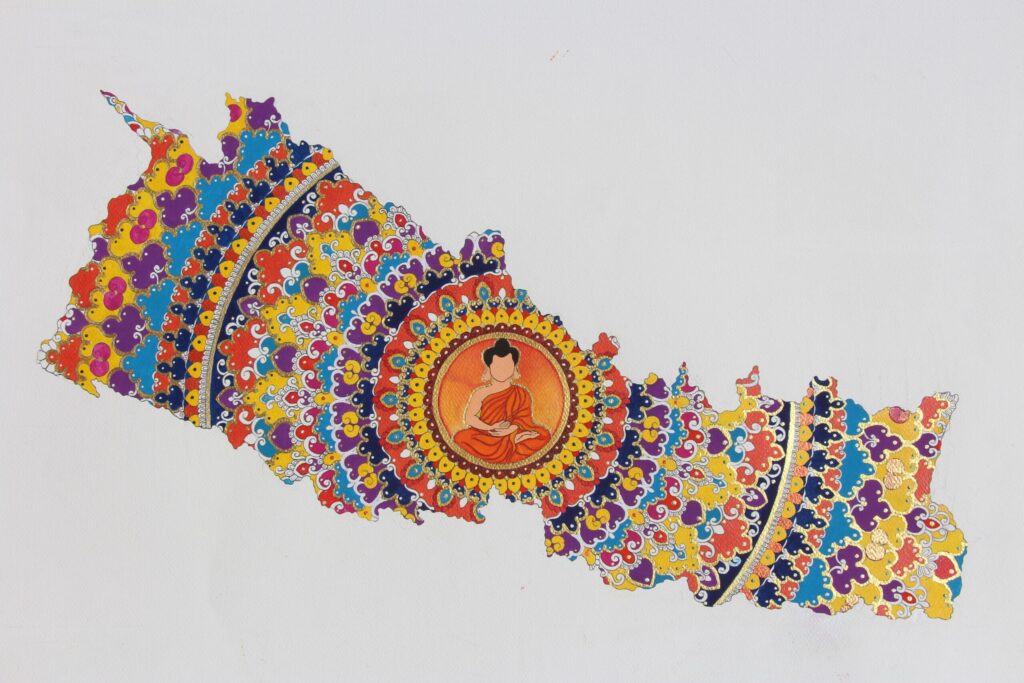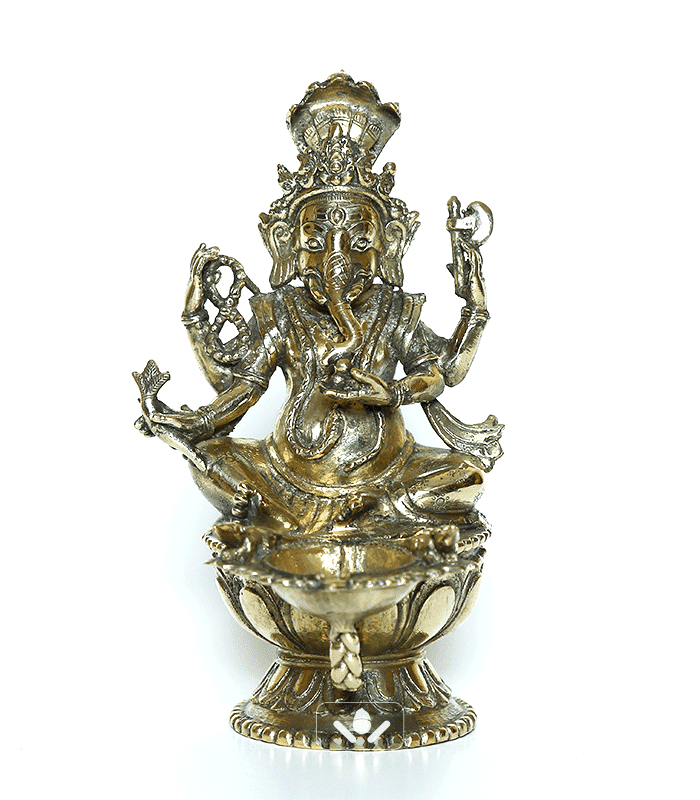Mandala Art in Nepal: Meaning, History, Uses & Why It’s More Than Just a Design

From ancient monasteries in the Himalayas to sacred spaces in Nepali homes, the mandala is far more than just a design—it’s a spiritual map, a meditative tool, and a sacred representation of the universe. In Nepal, mandala art is deeply rooted in Tibetan Buddhist practice, while also appearing subtly in Newar rituals as a reflection of the same spiritual philosophy.
At Swodeshi.com, we are proud to offer a curated collection of Mandala Thangka paintings, wooden mandala carvings, and framed mandala art, all crafted by skilled Nepali artisans. But beyond their aesthetic beauty lies a deeper meaning that connects art, spirituality, and healing.
What is a Mandala?
Table of Contents
ToggleThe word Mandala comes from Sanskrit, meaning “circle” or “center.” At its core, a mandala is a spiritual diagram—a visual representation of the universe that helps guide the mind from chaos to calm, from the outer world to the inner self.
In Tibetan Buddhism, mandalas are used in advanced meditation practices. They depict cosmic palaces with symmetrical geometry, concentric circles, deities, gates, and flames. These sacred blueprints help practitioners visualize the path to enlightenment, stage by stage.
Each color, shape, and symbol within a mandala carries spiritual significance, making it not just an artwork but a spiritual compass.
Origins and Tibetan Influence in Nepal
Mandalas first appeared in Indian tantric traditions, but their most intricate and symbolic forms were developed in Tibetan Vajrayana Buddhism. Over centuries, Tibetan monks preserved and expanded mandala traditions, especially through visualization meditations, rituals, and sacred art.
After the Chinese invasion of Tibet, many monks and craftsmen sought refuge in Nepal, particularly around Boudhanath and Patan, where they collaborated with local Newar artisans. These craftsmen, already renowned for their mastery in thangka painting, metalwork, and wood carving, began producing sacred Tibetan items with astonishing precision and reverence.
Even today, most authentic Tibetan mandala artworks are made in Nepal, sustaining both spiritual legacy and artisanal livelihoods.
The Structure of a Mandala: A Spiritual Blueprint
A traditional Tibetan mandala is highly structured, with spiritual meaning embedded in every layer:
- Center: The enlightened deity, representing the awakened mind.
- Inner Palace: The realm of wisdom, often layered with lotus petals, protective flames, or geometric patterns.
- Four Gates: Located at the cardinal points, symbolizing access to higher knowledge and consciousness.
- Outer Circle: Represents the universe, the barriers of ego, and the transition from material to spiritual awareness.
Mandalas can be flat paintings (like thangka) or even three-dimensional, such as temple layouts and stupas—all reflecting this sacred cosmology.
The Sand Mandala: A Lesson in Beauty and Impermanence
Among the most stunning and spiritual mandalas are sand mandalas, created by Tibetan monks using colored sand and extraordinary patience. These vibrant patterns can take days or weeks to complete—and yet, they are dismantled soon after.
This isn’t an act of destruction—it is a powerful teaching. The destruction of the mandala symbolizes impermanence (Anicca), one of Buddhism’s core principles. It reminds us that everything—even beauty, effort, and life itself—is temporary.
Interestingly, this same ritual gesture is found in Newar culture during Mha Puja and Kija Puja, where rice mandalas are made and then erased after the ceremony. Both practices teach humility, mindfulness, and acceptance of life’s transient nature.
How a Mandala Benefits Your Home, Pooja Room, or Workplace
A mandala isn’t just for monasteries or monks—it can bring peace, focus, and spiritual energy into everyday spaces like homes, offices, or meditation corners. Here’s how:
- Spiritual Energy in the Pooja Room
Placing a mandala thangka or wooden mandala in your prayer room brings a sense of divine order. Its sacred geometry aligns with cosmic principles, making it ideal for meditation, chanting, or introspection.
The center of the mandala represents enlightenment, making it a perfect spiritual focal point. It helps in focusing the mind and creating a peaceful, sattvic atmosphere.
- Harmony at Home
In your living room or bedroom, a mandala can subtly balance energy and bring in a calm, centering presence. Many believe that mandalas help reduce anxiety and stress simply by gazing into their symmetrical beauty.
The recurring patterns naturally draw the eyes inward—helping family members feel more grounded and connected.
- Focus and Creativity at Work
Mandala art in workspaces promotes mental clarity, inspiration, and focus. Whether framed on your office wall or kept on your desk, mandalas can help redirect scattered thoughts and create a balanced environment.
Some entrepreneurs and creatives use mandalas as a visual tool for goal setting, reflection, and alignment.
Why Mandalas Make Meaningful Gifts
A mandala is more than a beautiful gift—it’s a symbol of peace, blessings, and transformation.
- Perfect for Life Transitions
Whether it’s a housewarming, wedding, or new job, gifting a mandala symbolizes support and well-wishes for a harmonious new beginning.
- Expression of Love and Care
Mandalas speak the language of inner well-being. Gifting a mandala to someone struggling with stress, loss, or uncertainty is a subtle way of saying: “May you find your center.”
- Sustainable, Handcrafted & Cultural
When you choose handcrafted mandalas—like those from Swodeshi.com—you are not only giving a gift of meaning but also supporting local artisans and preserving spiritual heritage.
Meditation with Mandalas: A Practice for All
You don’t need to be a Buddhist practitioner to benefit from mandala meditation. Here’s a simple way to begin:
- Choose a Mandala that speaks to you—either a thangka or a framed art piece.
- Sit quietly and gaze at the center of the mandala, letting your breath slow down.
- As your eyes trace the patterns, allow your thoughts to settle.
- With regular practice, you’ll notice greater mental clarity, focus, and emotional balance.
Even 5–10 minutes a day can have profound effects.
Nepal: Home of the Mandala Artisan
Nepal is not just a trading ground for mandalas—it’s the workshop of the Himalayas, where spirituality and craftsmanship come together.
Most Tibetan thangkas, ritual mandalas, and wooden mandala panels available around the world are handcrafted in Nepal, especially in areas like Bhaktapur, Patan, and Boudha. These artisans often train for years under master painters or woodworkers, ensuring each piece carries authentic detail, sacred symbolism, and mindful energy.
By owning or gifting a mandala from Nepal, you are receiving something authentic, ethically made, and spiritually significant.
Final Thoughts: A Circle with No End
A mandala is more than a beautiful pattern—it is a sacred circle, a journey inward, a teaching on impermanence, and a reminder of balance. In Tibetan Buddhism, it reflects the path to enlightenment. In Nepali homes and rituals, it signifies order, protection, and transformation.
Whether you keep it in your home, gift it to a loved one, or simply admire its artistry, the mandala has the power to inspire, protect, and transform.
At Swodeshi.com, we honor this rich tradition by offering authentic, handcrafted mandala art made in Nepal with skill and soul. Each piece carries centuries of wisdom and devotion—ready to become part of your sacred space.
How useful was this post?
Click on a star to rate it!
Average rating 0 / 5. Vote count: 0
No votes so far! Be the first to rate this post.
Recent Posts
Featured Products
-
 Ashtamangal Puja Thali
NPR 690
Ashtamangal Puja Thali
NPR 690
-
 Ashtamangal mandap
NPR 1,790
Ashtamangal mandap
NPR 1,790
-
 Ganesh Sukunda - Traditional Oil Lamp 7"
NPR 4,600
Ganesh Sukunda - Traditional Oil Lamp 7"
NPR 4,600
-
 Gold-Plated Aparmita Statue
NPR 55,000
Gold-Plated Aparmita Statue
NPR 55,000
-
 Gold Plated Sahasar Bhuj Lokeshwor Statue
NPR 69,000
Gold Plated Sahasar Bhuj Lokeshwor Statue
NPR 69,000
-
 Gold Plated Namgyal Statue
NPR 33,600
Gold Plated Namgyal Statue
NPR 33,600




